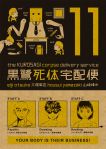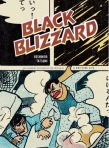After the announcement of one of my favorite annual award programs, the Great Graphic Novels for Teens, I decided it might be fun to look at all of the books in the top ten this year. Since the list is always interesting and varied, it’s less of a homework assignment than a usefully structured pleasure.
 I wish I could claim some metaphorical design in my first choice, but it was made at random. There’s nothing random about Drew Weing’s Set to Sea, though, which publisher Fantagraphics describes as “part rollicking adventure, part maritime ballad told in visual rhyme.” If that last part sounds a little pretentious, don’t worry. Fantagraphics’ solicitations always sound a little pretentious, even when they’re absolutely true.
I wish I could claim some metaphorical design in my first choice, but it was made at random. There’s nothing random about Drew Weing’s Set to Sea, though, which publisher Fantagraphics describes as “part rollicking adventure, part maritime ballad told in visual rhyme.” If that last part sounds a little pretentious, don’t worry. Fantagraphics’ solicitations always sound a little pretentious, even when they’re absolutely true.
Weing’s story does have the shapeliness of a poem, and it has the careful structure of a three-act play. It follows a would-be poet as he becomes an unwilling participant in the kind of seafaring adventures he tries to set to verse. In spite of his imposing size, he’s a tentative sort, and the brutality of life at sea takes a while to penetrate. When it does, he still maintains his artist’s viewpoint, and Weing neatly persuades us that art of any sort is better with some life experience to inform it.
That may seem to be a little ironic, given that Set to Sea is Weing’s debut graphic novel. He’s an experienced creator of webcomics, though, and that’s where this book was born. Consequently, each page is a single panel, but each of those panels is so attractively detailed and evocative that the storytelling structure never feels rigid. Instead, it comes across as economical and precise while still filled with event and emotion. It’s a quick read, but it’s very satisfying, and it just invites you to revisit the story again.
You could read it online, obviously, but the physical package is very handsome and worth the investment. In dimension, it’s like a diary or sketchbook that a traveler would carry, appropriately enough. Kevin (Robot 6) Melrose listed its cover as one of the best of 2010, and he’s quite right. The book itself wound up on a number of Best of 2010 lists, including Andrew Salmond’s and Martin Steenton’s at Forbidden Planet International, Brigid Alverson’s at Robot 6, and the Vulture blog of New York Magazine, and Glen Weldon of NPR’s Monkey See counted it among his most memorable comics and graphic novels of the year.
Set to Sea offers a wonderful beginning to this little project of mine. It’s artistically successful on every front, but Weing’s substantial craftsmanship never overwhelms the simple, heartfelt story he’s telling.
Other reviews in this intermittent series:
- The Zabîme Sisters, written and illustrated by Aristophane, First Second
You can nominate titles for the next Great Graphic Novel for Teen List, and you can take a look at the current batch of contenders.






































